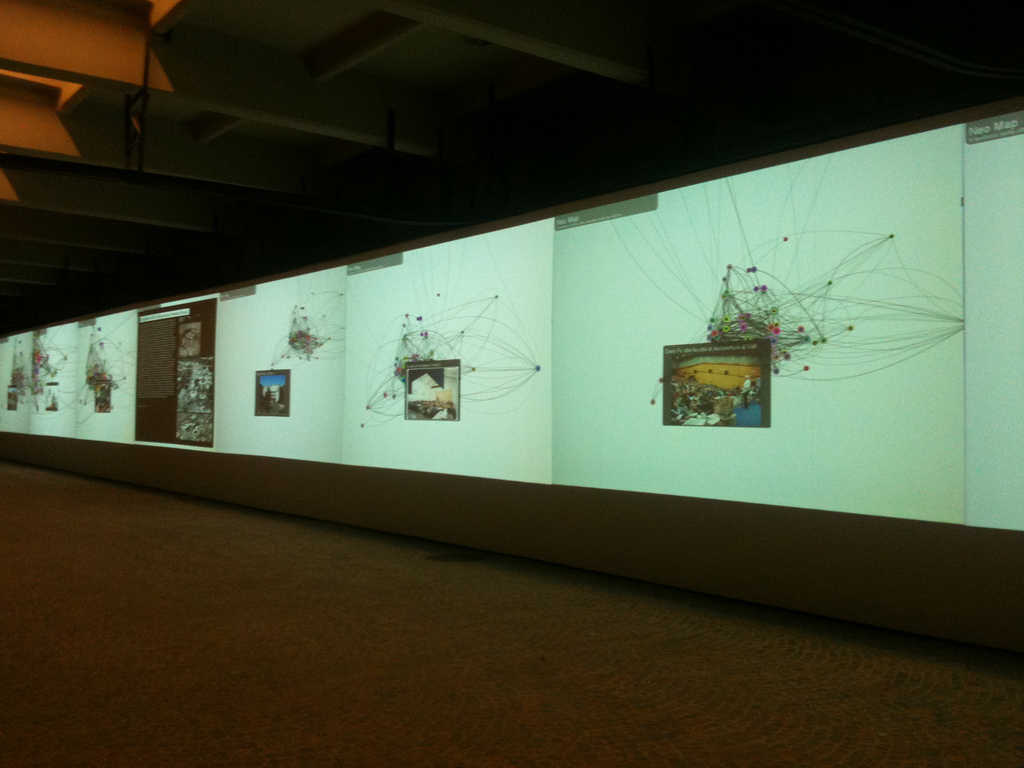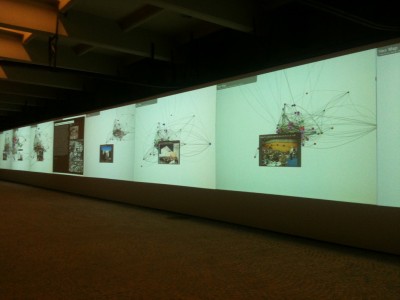[ ITALIAN ]
l’Atlante è un sistema aperto che raccoglie visioni sulla città. Progetti, azioni, pubblicazioni, siti web, teorie. Tutto ciò può essere incluso nell’atlante per creare uno spazio di informazione condivisa.
L’Atlante vive a cavallo dello spazio digitale e di quello fisico.
Sul web, un sistema aperto permette di inserire le proprie visioni e di consultare quelle presenti sul territorio, nel tempo e nello spazio semantico delle tematiche.
Nello spazio fisico l’Atlante si manifesta come una grande installazione pensata per essere inserita nello spazio pubblico. Qui le persone possono consultare l’Atlante sia osservandone le grandi rappresentazioni infoestetiche, sia utilizzando degli schermi multitouch che permettono di interagire direttamente con la superficie proiettiva cercando le informazioni secondo la navigazione per categorie e tag.
Le mura degli spazi pubblici si animano, comunicando la stratificazione di molteplici punti di vista, idee, progettualità, eventi e voci che definiscono la vita della città, le sue emozioni, i suoi desideri.
L’Atlante è un progetto aperto, istanziato per la prima volta per la città di Roma, dove è nato sotto la cura di Paolo Valente e commissionato dall’Ordine degli Architetti per la Festa dell’Architettura del 2010 (Index Urbis http://www.indexurbis.it/ ) con il nome di Atlante di Roma, con la fondamentale collaborazione dell’Assessorato alla Comunicazione e alle Politiche Culturali del Comune di Roma.
Il progetto si fonda sulla creazione di un complesso network di istituzioni, professionisti, accademici, e di soggetti che esprimono o raccontano nel loro operare quotidiano le visioni sulla vita e sulle possibili evoluzioni delle città, delle relazioni e interazioni tra i loro abitanti, dell’evoluzione degli spazi pubblici, dell’informazione e dell’interazione sociale.
L’esperienza si estenderà, nei prossimi mesi, ad altre città sia in Italia che nel resto del mondo.
[ ENGLISH ]
The Atlas is an open system gathering visions on the city. Projects, actions, publications, web sites, theories. Everything can be included in the atlas to create a shared information space.
The Atlas lives across digital and physical spaces.
On the web, an open system is used to add visions and to access the ones that are already present through territory, time and the semantic space.
In the physical space, the Atlas is a large scale installation designed for public spaces. Here people can access the shared information either visually, by observing the 35 meter wide information aesthetics, or they can directly interact with information by using multitouch screens allowing direct connection to the projected surface, browsing information through categories, territories and times.
The walls of the public spaces animate themselves, communicating the stratification of the multiple points of view, ideas, projects, events and voices that define the life of the city, its emotions, its desires and strategies.
The Atlas is an open project, instantiated for the first time in the city of Rome, where it has been curated by Paolo Valente and commissioned by the Order of the Architects for the Festa dell’Architettura 2010 ( Index Urbis http://www.indexurbis.it/ ) with the name “Atlante di Roma”, with the fundamental collaboration of the Council for Communication and Cultural Policies of the City of Rome.
The project is based on the creation of a complex network of institutions, professionals, academics and other subjects expressing or telling the visions on the life and on the possible evolutions of the city, of the relations and interactions among its citizens, of public spaces, of information and social interaction.
The experience will be replicated, during the next months, in other cities both in Italy and in the rest of the world.
——-
CREDITS
——-
a cura di / curated by:
Paolo Valente
Progettazione / Project:
FakePress ( http://www.fakepress.it )
Realizzazione / Implementation:
Art is Open Source ( https://www.artisopensource.net )
Interaction design, experience design, information aesthetics, sound & environment design:
Salvatore Iaconesi
Information architecture e network politics:
Oriana Persico
con la collaborazione di / with the collaboration of:
Alessandro Tartaglia
il team tecnico del partner technologico AVSet, a cui va un ringraziamento speciale, è composto da / the technical team of our technological partner AVSet, to whom goes a special thanks, is composed by :
Mauro Iezzi
Marco De Angelis
Gianluca Faustini
Maurizio Muglia
e
Bruno De Matteis
un ringraziamento speciale per / special thanks to:
Monica Scanu e Alessandro Ferrante per la creation del network legato alla rete museale del Comune di Roma e per le Accademie e gli Istituti Internazionali di Cultura di Roma / for the creation of the network of the museums of the City of Rome and for the Academies and International Cultural Institutes of Rome
L’Ordine degli Architetti Pianificatori Paesaggisti e Conservatori di Roma e Provincia http://www.architettiroma.it/
Festa dell’Architettura ( http://www.indexurbis.it)
Cultura Internazionale Roma ( http://culturainternazionale.wordpress.com )
Archiblog ( http://www.archiblog.it )
Performing Media / Urban Experience di Carlo Infante ( http://www.performingmedia.org/ e http://urbanexperience.ning.com/ )
Musei in Comune 2.0 e Marina Bellini ( http://museiincomuneroma.wordpress.com/ )
The Hub Roma ( http://www.hubroma.net/ )
Next Exit/Roma Creativa e Daniela Ubaldi
NextExit ( http://www.nextexit.it )
Roma Contemporanea e Rossella Reale ( http://www.mappaitaliacontemporanea.it )
Emmanuele Pilia ( http://piliaemmanuele.wordpress.com/info/ )
Valentina Giannicchi ( http://valentinagiannicchi.wordpress.com/ )
Hortus ( http://www.vg-hortus.it )
Paesaggio Critico ( http://paesaggiocritico.wordpress.com/ )
![[ AOS ] Art is Open Source](https://www.artisopensource.net/network/artisopensource/wp-content/uploads/2020/03/AOSLogo-01.png)

